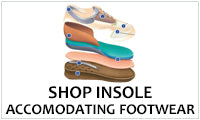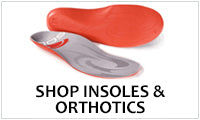How To Fit Orthotics In Your Shoes & Sandals
Having trouble putting your orthotics into your shoes?
Try these helpful tips and watch the how-to videos on this page to make sure you are using your insoles to their fullest.
- Remove existing insoles or footbed first.
- If your orthotic is too long, you can trim the soft topcover at the "toe end" with a scissor. Use the existing insole or footbed as a template.
- Choose shoes with extra depth, not longer or wider.
- Choose shoes that have adjustability. For example, shoes with laces, adjustable hook and loop closure strap or buckles.
What are Orthotics?
The term "orthotic" can refer to almost any device which is worn inside a shoe. Items called “orthotics” can be found in infomercials, retail stores and even at trade shows. There are three very different types of “orthotics” – custom, off the shelf, and ankle foot orthotics (AFO). The educated consumer should be aware of each type.
Custom molded foot orthotics provide protection against pain and injury. Custom orthotics can be specially designed to match your foot type, foot condition and activity level and are made by a podiatrist or other healthcare professional. Orthotics are not meant to fit in all shoes. You should select a shoe that has extra or added depth and a removeable insole. The shoe should also offer a stiff sole. Most shoes on our site offer removeable insoles. In order for your orthotics to provide you the best protection against pain and injury you should wear them as much as possible. But with sandal season coming, what can you do?
Yes, you can wear orthotics and wear sandals too! For comfortable feet and "freedom from shoes" we offer sandals that have removable insoles.
Custom orthotics for sandals allow you to enjoy custom-made comfort -- even when you don't wear shoes. Sandals are perfect after being on your feet all day, out on the job, or at the office. But, when you don't wear your shoes, you don't wear your orthotics either! In fact, clinical surveys have shown that orthotic patients may gain as much as 33% or more additional orthotic therapy time by wearing sandals or clogs with custom orthotics.
Off-the-shelf orthotics (often called arch supports) are usually found in retail stores - including sport stores, shoe stores online stores and pharmacies. They are non-custom devices designed to provide gentle support to the arch of the foot and help spread weight more evenly along the bottom of the foot. They are sometimes called "prefabricated orthotics."
An “Ankle Foot Orthotic” (or AFO) is a special brace that is designed to help control the motion of the ankle joint and also offer support to the foot. The Functional AFO is a type of AFO that is designed to offer superb control for the foot and ankle while offering greater comfort and easier shoe fit than other braces. It is custom made for your foot and ankle and combines a custom foot orthosis with an attached semi-rigid ankle brace. It is the only brace available that controls the motion of the ankle joint and the motion of both of the major joints of the foot.
There are multiple reasons that your physician may have suggested this brace. Most commonly the brace is used to control a severe flatfoot, an unstable ankle, or a foot/ankle with abnormal or painful motion. By controlling motion, function is often improved and pain is decreased.
This unique brace is custom fit to your foot and ankle, so it "hugs" your ankle comfortably. This allows better fit in shoes than most braces. All AFOs, however, require a stable lace-up shoe, and the Functional AFO is no exception. It is very important that shoes are purchased after the brace is fitted.

